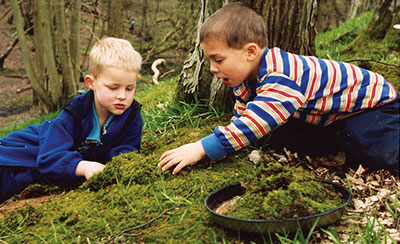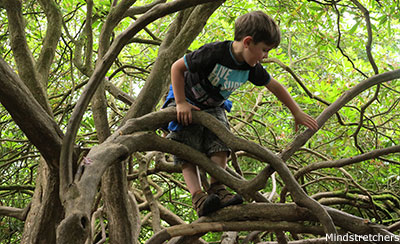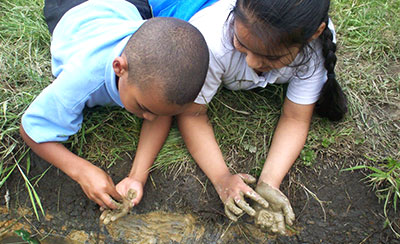The importance of nature in the early years
Why children should put the pencil down and go outside
| September 2016Introduction
The world is full of expectation and possibility for young children from the moment they are born. Babies have an immense drive to learn, whatever their abilities, and are pre-programmed not to give up on the difficult developmental challenges of learning to smile, sit, crawl, stand up and so on. Children born with individual needs and/or disabilities need to go outside and experience nature even more than their peers to experience the reality of it. However, increasingly as younger and younger children are placed in childcare for longer hours and others go to school at earlier ages and stages than ever before we need to consider the importance of a natural balance, and experience outdoors as well as inside for all children – but this is often disregarded when they are seen as “special”. Many practitioners and teachers have also grown up without the rich experience of nature and outdoor play themselves. Their life inexperience and, sometimes, ineffective training can be difficult to change or alter as they themselves are resistant to going outside as they see it as hard to manage as well as cold, wet and inhospitable.
The influence of pioneers
The history of nature and outdoor play started long ago with Comenius (1592–1670). He was the originator of the concept of “natural education.” This concept was then built upon by Rousseau (1712–78) who created the image of the “free child” in his work Emile.
Pestalozzi (1746–1827) gave us “education according to nature”. He recognised that all children thrive outdoors where their minds and bodies develop best through play and real experiences. He greatly influenced Froebel (1782–1852) who created the first kindergarten and the concept of first-hand experience.
Later still, Steiner (1861–1925) fostered social development through the rhythm of the day, farming and the seasons. The ethos of children feeling part of a natural cycle of the year and the importance of having a responsibility to the world by being embedded in it come from his work.
In Britain the work of Margaret McMillan (1860–1931) and her sister Rachel fostered nature and wellbeing via the nursery garden, particularly for young children living in poverty.
The strong links between being outside with nature as a relationship has developed from using the “hands, heart and head” approach favoured by Sir Patrick Geddes (1854–1932), the Scottish town planner who gave Edinburgh so many of its wonderful nursery school and tenement gardens via his philosophy that nature will be available for first hand inspection and thus for education.
More recently Dr Susan Isaacs (1885–1948) fostered natural curiosity, children”s relationship with nature and learning in the real world around them leading to them learning via discovery, reasoning and thinking through exploration.
The children's garden and Froebel
It is interesting to note that in 1839 when Froebel was establishing his training programme for teachers at Blankenburg, Germany, he stipulated that those attending should be “mature and knowledgeable”. Froebel expected them to “observe children throughout the four seasons”. From his nearby school in Keilhau weekly nature walks were encouraged as so much could be taught during them. Froebel was focused upon nature as being central to a child”s experience of the “unity of all things” emphasising our connectedness to the world we live in and the learner”s active participation as the agent for learning. Similarly Montessori also emphasised the need for children to interact with nature. She felt that access to the outdoors should be an extension to the classroom.
Nature benefits to young children today
Children are often really fascinated by nature and natural things. Consider a toddler handling pebbles, leaves, shells and sticks – the engagement and deep fascination with the objects are powerful because of their variety of properties, which differ so radically from the more standardised play items found indoors. Our children of today are becoming more and more distant from nature, and it is inherent in this technological age that our children are spending less time outdoors. How can children then learn to love and respect something that they have little or no relationship with?
There is a clear benefit of nature for children with special needs in that they go at their own pace outside and find “things” to play with and learn from. Through experiential experience they learn to use their imagination more, developing their thinking and problem-solving skills in a developmentally appropriate manner led by their own interests and drive. Such core experience as being cooler, feeling rain, snow and sun on your skin are so important.
As pressure on space increases particularly in urban areas, the freedom to play outside has also declined. Homes have become smaller and many children have no access to a garden to play in. Parents are increasingly busy with work and thus choose to play indoors with their children at the end of a long day. They can also structure children”s time in ways that leave little scope for discovery outside in their desire to look after their “special” child. The demands of modern life also mean they are transported by cars and buggies and are far less likely to interact with nature.
Risk aversion
The other major influence are risk-averse families and practitioners who whilst naturally wishing to protect children from harm choose to over-protect them so they will not learn essential life skills such as assessing risk and hazards. By allowing them to take “considered risks” like walking across a log over a shallow stream or climbing to the next branch of a tree can have numerous benefits for all children, not least helping their sense of balance and confidence in their own abilities. Thankfully children are pre-programmed to take risks and children are often more capable than we give them credit for and so rather than stifling their sense of adventure, outdoor play in nature can actually help to develop it.
There is a great deal of research and evidence from varied sources, which demonstrates the importance of children being outdoors and learning about risk benefits. These include: Tovey (2007) takes the view that risk is a natural part of life: “bumps, bruises, tumbles and falls are part of learning and we must not succumb to overwhelming anxiety or recklessness.”
Gill (2007) in “No Fear; Growing Up in a Risk Adverse Society” notes that children naturally seek risk and challenge as an “essential part of living a meaningful and satisfying life”.
Finally, Judith Hackett: Chief Executive of the Health and Safety Executive (2015) who has insisted that children should not be wrapped up in cotton wool leading to them becoming “risk naïve” later in life. She insists that risk avoidance has come from well meaning but over zealous teachers who have misinterpreted the H&S guidelines. She also blamed the compensation culture of blame. She said: “Children should be able to play, fall over and hurt themselves.”
The interplay of learning and experience between the natural world and risky play is complex but there are certain categories of risky play which attract children worldwide as Ellen Sandseter, (2011) a Norwegian professor has identified:
- Height
- Speed
- Tools
- Elements
- Rough and tumble
- Hiding and privacy
Clearly an appropriately challenging nature garden could achieve these and provide for a range of locomotor development carefully tailored with the addition of a few resources such as wheeled vehicles, gardening tools, ropes, ladders, dens, plus basic materials including sand, water and mud alongside nature walks, forest school experience and similar opportunities.
Special needs: What is possible outdoors?
The EYFS (2012) states:
Being outdoors has a positive impact on children's sense of well-being and helps all aspects of children's development. Being outdoors offers opportunities for doing things in different ways and on different scales than when indoors. It gives children first-hand contact with weather, seasons and the natural world. Outdoor environments offer children freedom to explore, use their senses, and be physically active and exuberant.
Before taking “special” children outside it is important to think about what they can learn. There are a huge array of opportunities including free play, environmental education, adventurous activities and solo and group challenges. The special nature of being outside must include the unique experiences of:
- The weather - showers, heavier rain and rainbows, gentle breezes and strong gusty wind, ice, snow and frost and sunshine.
- The seasons, which adds so much interest, colour and richness.
- The freedom of space and topology.
- The actual environment and landscape – mini-beasts, woods, forests, fields, parks, beaches, hills and even mountains.
However, for convenience the garden, playground or park are the nearest places for young children to experience nature. These places also allow for an informal “less is more approach” where practitioners can rely on material found in situ to inspire and fascinate as outside also allows for the unexpected to happen. The emotional nurturing “aah” and “ugh” experiences may not all be pleasant but link better to indoor learning being based upon concrete experience, which later become the children’s own narrative stories.
Growing all children
The experience of nature for young children needs to be softer and more enclosed than that for adults. Hard edged, high energy boisterous play is not for all children and the use of plants can create sheltered calmer places for stimulating different kinds of play alongside experiences of growing plants, and hands-on often intimate experience of wildlife, awe and wonder. Growing is an area of great fascination for children and offers much experience of “learning by doing” alongside physical activity, collaboration, talk, healthy eating and the foundation of lifelong positive attitudes. The provision of a variety of seeds, water, containers, soil or peat-free compost, simple tools and protective clothing including child-sized gloves are essential. Growing beans, potatoes or herbs, wildflowers or flowering annuals are all relatively easy and very satisfying.
The importance of knowledgeable and enthusiastic practitioners is of course crucial to both providing, adapting and unlocking the potential of outdoors. Nature offers rich stimuli and the chance to be inquisitive, exploratory, adventurous, innovative and messy in ways never feasible indoors. Even the most disabled child, in my experience gains a real experience from being outdoors. Practitioners who understand this and who value and enjoy nature themselves will enable children to make best use of nature by following child-led learning.
Those all important relationships and creativity
The need for children to play freely outdoors in nature in all sorts of weathers leads to a variety of informal learning as well as lifelong interests. Children who are kept indoors tend to be frustrated and sometimes behave aggressively as Wendy Titman’s two-year research project “Special Places, Special People” (1993, 58) indicated. She suggests that outdoor environments for children need to “offer the potential for children to ‘do’ and ‘think’ and ‘feel’ and ‘be’ all at the same time.”
As part of our role in developing children’s creativity we need to offer opportunities outside to enhance their capacities for such areas as thinking, transferring and applying skills and problem-solving, channelling feelings and emotions and developing a “can do” attitude. They should also experience solitude and spirituality through awe and wonder. There has been a rise in evidence that demonstrates the importance of contact with nature as being highly beneficial in these areas as well as in helping us to concentrate and relax. The “added value” of bringing nature to children provides strong emotional context for growth and is an amazing stimulus for communication as well as starting to care for our planet.
Through being outdoors young children can learn many skills of social interaction and friendship through first hand experience with a range of natural materials. Their curiosity and ability to become “lost in the experience” satisfy deep urges and allows them to also become part of a rich culturally diverse community. This is turn gives them a sense of belonging. These create like any good recipe, an environment of interactions which in turn build relationships, social skills, fun and enjoyment of being with peers and adults.
Thus by embedding an outdoor approach to play and learning, nature will assist us in helping all young children to both learn holistically across the whole curriculum and become better future citizens just as the pioneers suggested all those years ago!
Bibliography:
Bilton, H. (2002). Outdoor Play in the Early Years: management and innovation. London: David Fulton.
Department for Education (2012). Development Matters in the Early Years Foundation Stage: Non Statutory Guidance Materials Supports Practitioners in Implementing the Statutory Requirements of the Early Years Foundation Stage (revised edition). London: Department for Education.
Gill, T (2007). No Fear: Growing Up in a Risk Adverse Society. London: Calouste Gulbenkian Foundation.
Higgins, P. and R. Nicol (2011). Sir Patrick Geddes: “Vivendo Discimus” – By Living We Learn. In: Kemp, C and Smith, T (eds.) Sourcebook for Experiential Education: Key Thinkers and their Contributions. New York: Routledge pp. 32–40.
Louv, R. (2005). Last Child in the Wood: saving our children from nature-deficit disorder. London: Atlantic Books.
Sandseter, E. (2011). Children’s Risky Play from an Evolutionary Perspective: The Anti-Phobic Effects of Thrilling Experiences Department of Physical Education, Queen Maud University College of Early Childhood Education (DMMH), Trondheim, Norway. 2011. 9(2): 257–284.
Solly, K. (2014). Risk, Challenge and Adventure in the Early Years. London: Routledge.
Titman, W. (1993). Special Places, Special People: The Hidden Curriculum of School Grounds. Winchester: World Wide Fund for Nature/Learning Through Landscapes.
Tovey, H. (2007). Playing Outdoor: Spaces and Places, Risk and Challenge. Maidenhead: Open University Press.
First published in Montessori International, Summer 2016, Issue 119.










